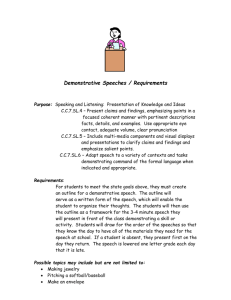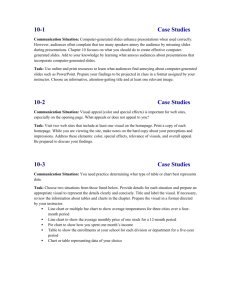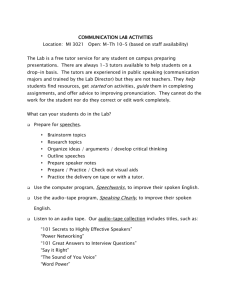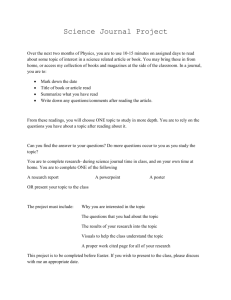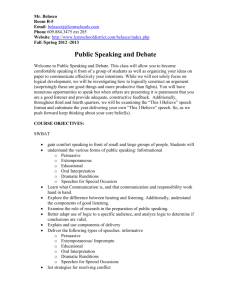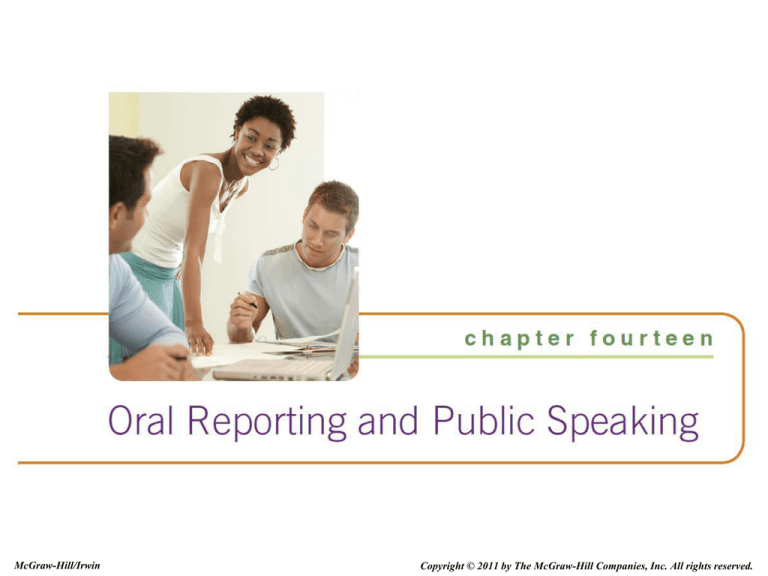
McGraw-Hill/Irwin
Copyright © 2011 by The McGraw-Hill Companies, Inc. All rights reserved.
Overview
•
•
•
•
•
•
Reporting orally
Making formal speeches
Preparing to speak
Using visuals
Giving team (collaborative) presentations
Presenting virtually
14-2
Planning the Oral Report
•
•
•
•
•
•
Plan oral reports just as you do written ones.
Determine your objective.
State its factors.
Organize the report: indirect or direct order.
Divide the body based on your objective.
Use introductory/concluding paragraphs.
14-4
Making Formal Speeches
• Speak on a topic in your area of specialization
and of interest to your audience.
– Topics assigned to you can include
• A welcome address.
• Delivery of acceptance of and honor or award.
• An announcement of a charity drive.
– Topics you pick should reflect
• Your background and knowledge.
• The audience’s interests.
• The occasion of the speech.
14-5
Making Formal Speeches
• Gather information:
libraries, company files,
the Internet, interviews.
• Organize
– Introduction
– Body
– Conclusion
14-6
Making Formal Speeches: Introduction
• Use an appropriate greeting (“Good
morning”).
• Arouse interest.
– Story
– Humor
– Quotation
– Question
• Introduce the subject (theme).
• Prepare the reader to receive the message.
14-7
Making Formal Speeches: Body &
Conclusion
• Body
– Divide the whole into comparable parts.
– Apply conventional relationships of data (time, place,
quantity, factor, combination).
– Use factors for presenting issues and questions.
– Connect major points with transitions.
• Conclusion
– Restate the subject.
– Summarize.
– Consider using a climactic close.
14-8
Making Formal Speeches: Delivery
• Extemporaneous: usually best
• Memorizing: risky
• Reading: difficult and unnatural
14-9
Preparing to Speak
• Extemporaneous: from notes, rehearsed
• Memorized: the most difficult, hazardous
• Reading: typically dull, mechanical
14-10
Audience Analysis
• Preliminary
– Number of audience members
– Characteristics (education level, gender, age, etc.)
• During the presentation
– Respond to feedback (smiles, frowns, blank stares,
applause).
– Adjust as you speak to accommodate feedback.
14-11
Consideration of Personal Aspects
• Confidence
– Preparing well
– Dressing appropriately
– Talking in strong, clear tones
• Sincerity
• Thoroughness
• Friendliness
14-12
Appearance and Physical Actions
• The communication environment—the things that
surround you as you speak
• Your appearance—how the audience sees you
– Posture
– Walking
– Facial expressions
– Gestures
14-13
Using the Voice Effectively
•
•
•
•
•
•
Vary Pitch.
Change Speaking Speed.
Use Vocal Emphasis.
Develop Pleasant Voice Quality.
Imitate speakers you admire.
Analyze your speeches and develop plans for
improvement.
14-14
Use of Visuals
• Use of visuals is determined by the
– Content of the report or presentation.
– Cost.
– Audience size.
– Ease of preparation.
– Facilities and technology available.
14-15
Using Visuals: Techniques
• Select the types that do the best job.
• Blend the visuals into your speech, making
certain that the audience sees and understands
them.
• Organize visuals as a part of the message.
• Emphasize the visuals by pointing to them.
• Talk to the audience, not the visuals.
• Do not block your audience’s view of the visuals.
• Use PowerPoint to enhance content.
14-16
Team Presentations
• Plan to incorporate ideas on individual
speeches and collaborative writing.
• Plan order and content.
• Plan physical factors.
• Plan staging.
• Plan a closing and Q & A session.
• Plan to rehearse the presentation.
14-17
Presenting Virtually
• Virtual Presentation
– A presentation delivered from a desktop over the
Internet to an audience anywhere in the world
14-18
Delivering a Virtual Presentation
• Before the presentation
–
–
–
–
Plan for the technology being used.
Mail announcements to the audience.
Test the technology.
Secure technical and non technical support to be available
during the meeting.
– Have material for early arrivers to view.
• During the delivery
– Plan interaction with polling or quizzing.
– Take regular breaks for feedback and questions.
– Be attentive to the feedback from the audience and adjust the
pace of the delivery.
– Allow ample time for both questions and evaluation.
14-19
Everything becomes a little
different as soon as it is
spoken out loud.
—Hermann Hesse
14-20

